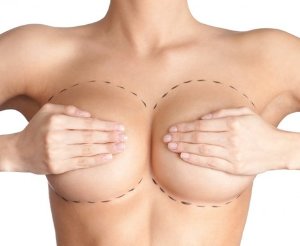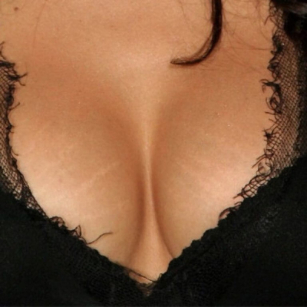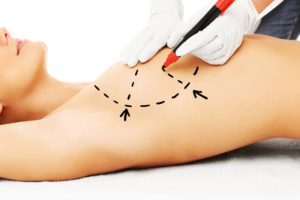
Breast ptosis, or sagging, is an aesthetic problem that worries many women. She adds self-doubt and her sexuality.
If a woman is concerned about this, she is embarrassed in front of her husband or boyfriend. Breast lift surgery is worth trying.
This procedure should not be confused with breast augmentation with implants. The lift aims to eliminate ptosis and give the female breast a natural elasticity.
What is this procedure like, what is it called?
A breast lift is called a mastopexy.In this procedure, the mammary glands are reshapedto give them natural elasticity and an attractive appearance without the use of implants. The operation is performed with minimal surgical intervention under local or general anesthesia.
The degree of ptosis plays an important role in its choice. There are 4 degrees of the disease. Appropriate measurements are taken to provide an accurate diagnosis. The degree of sagging is determined by the distance from the breast fold to the nipple.
Help!Ptosis is stages 1, 2, 3 and 4 and is measured by the distance from the breast fold to the nipple. A drop of 1-2 cm is considered uncritical and relates to grade 1.
When the nipple is 8 cm or more below the breast fold, a grade 4 ptosis is placed. Here surgeons have to cut off a large amount of skin and fat tissue, and without general anesthesia this is impossible.

Measured values
The skin on the chest is sensitive to changes in the body. There is no natural muscle frame underneath to maintain its shape. Therefore, it is difficult to keep its original shape throughout life. Reasons for changing the shape are:
- A sharp increase or decrease in weight.Stretchy skin on the chest after losing weight loses its elasticity and looks flabby.
- Large breast size.Breasts over 3 sizes sag under natural weight.
- Changes in the hormonal background.A lack or excess of hormones contributes to breast swelling or "deflation".
- Operations. For example, when a malignant tumor is removed, the glands become asymmetrical. In severe cases, the mammary gland becomes empty and flaccid.
- age.The chest, which has no muscle support, loses its elasticity before the rest of the body.
- Wrong fitting bra.If it doesn't provide adequate support, the mammary glands will sag prematurely.
- Breastfeeding.Mammary glands filled with milk can enlarge 3-5 times. After breastfeeding is complete, it will return to its previous size, but not its shape.
- Congenital anomalies.Breasts may stop developing properly after puberty. The only way out is to correct the shape.
Another problem with sagging breasts is that they tend to be accompanied by stretch marks and sagging skin.
Contraindications, restrictions
Mastopexy implies a surgical intervention in the body. Each operation has its own indications and contraindications. This type of operation is not prescribed in some cases:

- pregnancy or planning, as all the results of the operation fade;
- less than 12 months after the end of hepatitis B, the mammary glands need so much to recover from lactation.
- Presence of tumors in the chest area;
- acute infectious diseases;
- diabetes mellitus;
- kidney failure;
- cardiovascular dystonia;
- under 18 years of age (parental consent and medical emergencies required);
- Obesity, which is a result of metabolic disorders and can cause complications after surgery.
Before you decide on a mastopexy, you should weigh the positive and possible negative consequences.
Views
Breast lift can be performed with or without surgery.In the first case, the tissue removal method is used according to different schemes, the second is the effect on the deep layers of the skin. It should be noted that non-surgical methods are best used for the prevention of ptosis or in its early stages. Surgical interventions help fix the problem in more advanced cases.
Endoscopic
Small areas of skin are incised in the lateral area of the breast.Endoscope and instruments are inserted through them. The tissue is cut out from the inside so that surgery is invisible after the scars have healed.
This is one of the most expensive types of mastopexy. The success of this procedure depends on the qualifications and experience of the doctor performing the surgery. However, the result remains unchanged for 10-15 years. Endoscopic mastopexy can eliminate ptosis of any severity.
Periareolar (circular)
During thisoperation, the doctor cuts off excess tissue around the areola.This way you can not only tighten the mammary glands, but also change the diameter of the nipple. Traces of surgery and healing become invisible.
Among the disadvantages there is a possible impact on breastfeeding. Also, it is only used at 1 and 2 degree sags. After the operation, some patients experienced a loss of nipple sensitivity.
Vertical

During theoperation, the surgeon makes incisions across the breast and along the edges to lift the nipple.This method requires minimal intervention in the structure of the mammary glands and causes practically no complications and maintains the natural shape of the breast. It can also help shrink the nipple.
This method is used in the early stages of ptosis. It cannot be used if there are already scars on the chest. It does not help with extremely sagging breasts.
Anchor (T-shaped)
Displayed for severe ptosis or large breasts that are uncomfortable. During aoperation, an anchor or an inverted T-cut is made in the chest.Next, the surgeon cuts off excess tissue and the lower part is pulled up.
The operation has a pronounced aesthetic effect. It can be repeated until the patient is satisfied with the result. The disadvantages include making a large number of cuts. This increases the rehabilitation time and can lead to complications.
Laser
This is a relatively new type of breast lift. It is widespread in the west, but in our country there are a small number of clinics with the necessary equipment.Breasts can be lifted and enlarged with the laser.No scalpel is required for this.
Laser lifting is effective in the early stages of ptosis. It takes about 6 treatments to achieve the desired effect. They are carried out at least 14 days apart. The procedure does not require the introduction of anesthesia as it is painless. In some cases, there may be unpleasant sensations.
Mesothreads
If the breast has lost its previous elasticity and is causing a woman internal discomfort, doctors recommend a procedure for implanting mesothreads. It leaves no marks on the skin and has no complications.
In the mammary glands, thethreads are gradually overgrown with fatty tissue and produce a supporting effect.The threads continue to work for 6-8 months. Then they are completely absorbed and do not need to be removed.

Non-surgical methods
Women with 1st degree breast collapse are recommended to use non-surgical breast lift methods. They help restore the skin's elasticity and bring the mammary glands back to their previous shape:
- Myostimulation - With the help of electrical impulses that are sent via the connected electrodes, the skin's elasticity is restored and stretch marks are eliminated.
- Lipolifting - transplantation of fatty tissue from the abdomen and inner thighs into problem areas of the breast. Guaranteed 100% adipose tissue transplant.
- Micro currents with serums - provoke the active production of elastin and collagen, accelerate cell renewal, reduce seams and stretch marks.
- Mesotherapy.
The choice of lift type is also influenced by the degree of stretching of the breast skin, its asymmetry and size. The surgeon assesses the general condition and selects the safest and most effective option for each individual case.
Preparation for plastic surgery
Before the surgeon is given permission to perform a breast lift,must consult other specialists: gynecologist, therapist, mammologist and anesthetist.You must also pass a number of tests:
- general and biochemical blood tests;
- blood test for diabetes mellitus;
- general urinalysis;
- -analysis for hepatitis, HIV, syphilis;
- EKG;
- breast ultrasound;
- mammography;
- fluorography.
14 days before and for the same period after the operation you must not smoke, take alcohol or drink drugs that affect the density of the blood, including oral contraceptives. You should also give up intense physical activity. Immediately before the operation, no food should be eaten for 12 hours before the operation. You can drink tea or water.
How is it done, is it dangerous?

How is the process carried out?Mastopexy is safe.It starts with a chest mark. The surgeon marks the interfaces and skin areas to be removed with a marker. Then the patient is anesthetized. There can be several types:
- intravenous;
- inhalation;
- local.
Mastopexy stages:
- the surgeon makes incisions along the markings;
- also forms the end result and cuts off excess skin and fatty tissue;
- If necessary, the surgeon will reduce the size of the nipples.
- After that, sutures and an antibacterial bandage are put on, and drains are put in (you can read more about what the sutures are and how long they will heal after the operation).
Operating time from 1. 5 to 3 hours.
What happens in the postoperative phase?
- The patient regains consciousness almost immediately after the operation.Chest pain begins when we recover from anesthesia. The doctor who performed the surgery should advise about pain relievers and antibiotics to take in the postoperative period.
- 3 days after the mastopexy, the patient is observed in the hospital.If no complications arise, she is discharged. The doctor should evaluate the primary result, namely whether the stitches are starting to narrow and whether there is any asymmetry. After a week, the stitches are removed.
- In the first week after surgery, edema is observed.The chest looks stone. The swelling persists for the first month and bruises may appear. After 1-3 months they completely disappear, you can evaluate the result. During this time, the stitches heal completely, edema and hematoma subside.
- Corrective underwear must be worn for the first six monthsto maintain shape, use ointments that accelerate skin regeneration. This will help to get through the rehabilitation phase faster.
- In addition, you are not allowed to visit the bathhouse, the saunawithin 6 months after the operation, in order not to infect the open seams. It is forbidden to go to the gym and lift weights - this will contribute to the divergence of the seams.
Patients who opt for mastopexy should also be aware of possible complications. These include pain in the mammary glands, bruises and bruises, swelling at the interfaces, inflammation of the tissue, and loss of sensitivity.
Before and after photos

Below in the photo you can see what a large breast looks like before and after a lift.
Cost of the procedure
The cost of the service depends on the type of operation, the qualifications of the surgeon and staff, and the status of the clinic. The price also includes an exercise program, purchase of corrective underwear, patches and anesthesia.
Mastopexy is an opportunity for every woman to feel her sexuality and attractiveness again. But before deciding to take a serious step, it is worth studying the information about this operation, comparing the positive aspects and possible risks, and only then make the final decision.
Mammoplasty is a type of surgery to correct the shape and size of the breast. The specialist changes the contour, volume of the mammary glands, the shape of the nipples and areolas.




























